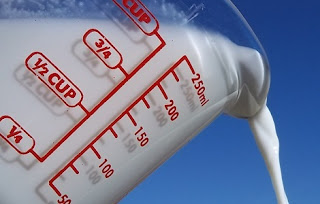We all know we need calcium for the development and maintenance of strong bones, teeth, nerves, and muscle, but we don't always get enough in our diets. Whether you are allergic to dairy, lactose intolerant, or just plain don't like milk you're probably concerned about whether or not you are getting enough calcium in your diet.
Here are 5 whole foods that are surprisingly high in calcium. We'll compare them to a 1 cup (8 fluid ounces) serving of whole milk, which has 276mg of calcium, to see where they stand.
Almonds
According the the USDA one cup of whole almonds contains approximately 378mg of calcium. Compared that to the 276mg of calcium in the same measure of whole milk, and we see a startling difference.
Of course, eating an entire cup of whole almonds is another story. But, for those who like to snack on nuts, making almonds an essential part of your mix will help to greatly increase your calcium intake. Other ways to get large amounts of almonds into your diet is almond butter, sliced almonds in salads, roasts, and casseroles, or in cookies.
Collard Greens
Cooked or raw, collard greens are excellent source of calcium. What makes the biggest difference in their calcium content is whether or not they were frozen for packaging. Collard that was frozen hours after picking has 357mg of calcium per cup, compared to 266mg per cup when bought raw in the produce section of your store. If you want to add the greens to a soup or stew it's recommended that you buy them frozen. Either way, collard greens give milk a run for it's money when it comes to calcium content.
Rhubarb
Who would have imagined that rhubarb pie would be so good for you? Frozen rhubarb, drained and cooked in sugar, has 348mg of calcium per cup. I'm sure you can try preparing it with an alternative sweetener if you don't want to deal with all that sugar. Either way, this adds a sweet treat to the list of calcium rich foods.
Spinach
Like collard greens buying it frozen or picking it fresh from your own garden makes a big difference. But, unlike collard, so does cooking it. Raw spinach doesn't offer as much elemental calcium as cooked spinach does. The reason for this is oxalate, which binds to calcium and prevents it from being absorbed by the body. Cooking it breaks these binds and allows the extremely high amount of calcium in spinach to be properly digested. One cup of frozen, then cooked spinach contains 291mg of calcium per cup. Raw it only contains 30mg.
Leavening Agents
That's right, baking powder is an amazing source of calcium. If you ever look on the package of 'self-rising' flour, corn meal, or other similar products you'll notice that they are very high in calcium. This is because they have baking powder, double acting agents, or straight phosphates in them, which are very high in calcium. 339mg per teaspoon, to be exact, which comes out to 16,272mg per cup! Take that milk!
Of course, drinking milk is much easier than eating an entire cup of baking soda. But if you consider the average recipe for baking soda biscuits, which normally call for 4 teaspoons of baking soda, then divide the dough by 15 (normal amount of biscuits made from one batch), that comes out to just over 90mg of calcium per biscuit. Not bad when you're looking for ways to get more calcium in your diet without giving up the foods you love.
Sesame Seeds
In my house whole sesame seeds are the beauty queen of non-dairy foods that are high in calcium. At 1404mg of calcium per cup they make it easy to get extra calcium into my children's diets. Toasted and sprinkled on salads, added to soups, and even in cookies, it is a very versatile food.
Other Foods High In Calcium
There are a lot of other foods that are high in calcium, though maybe not as much as milk. They include broccoli, kale (seaweeds), brussel sprouts, beans (white, baked, blackeyed, etc), tofu, bok choy, peas, and okra. Likewise, sardines and salmon, canned with the bone, are extremely high in calcium.
If you're on a dairy-free diet, or just have a hard time getting your kids to drink milk or eat cheese, these are all great foods to help you overcome any potential dietary calcium deficiency.
Here are two recipes to help get you started:
Collard Greens Soup with Chicken
Serves 5
4 lbs chicken (your choice)
1 large yellow or red bell pepper, cut into 1 inch strips
3 cloves garlic, minced or mashed
1 cup diced white or yellow onion
1 cup salted sliced almonds
3 extra large mushrooms, cut into eighths (1/8)
8 brussel sprouts, halved
1/2 pound broccoli crowns, with stems removed
1 firmly packed cup thinly sliced ribbons of collard greens
3 tablespoons extra virgin olive oil
8 cups chicken or vegetable broth
salt to taste (optional)
Pre-heat pressure cooker on medium heat. Add in olive oil, followed quickly by belle pepper, garlic, onions, and almonds. Cook until onions are clear, stirring frequently. Add remaining ingredients. Stir or press down with spoon to ensure all ingredients are mixed and wetted.
Place and lock lid on pressure cooker. Turn heat up to high until cooker achieves a proper pressure lock according to manufacturer's instructions. Reduce heat to medium-low and cook for for 20 minutes.
Quick Sesame-Peanut Butter Cookies
1 cup peanut butter
1/4 cup whole toasted sesame seeds
1 cup sugar
1 large egg
Preheat oven to 350 degrees. Combine all ingredients in large bowl, until crumbly dough is formed. Using dinner spoon, form dough into 1-inch balls and place on parchment covered cookie sheet. Press down with fork, making a criss-cross hatch.
Bake for 8-10 minutes, let cool on cookie sheet before removing to plate or cookie jar. Makes 24 cookies.
